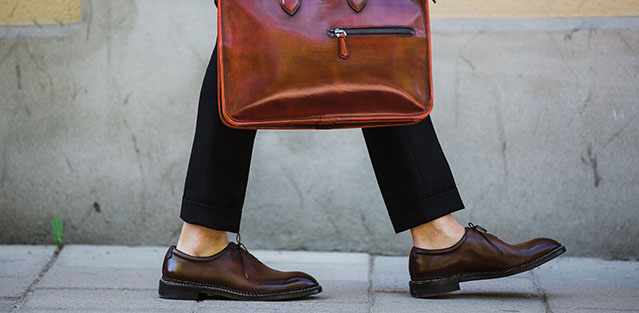
THE ART OF PATINA
For someone who loves shoes, what better than a pair that resembles no other on earth, a pair that’s unique? The Berluti patina allows limitless liberty in variation and interpretation.

In the 1980s, Olga Berluti perfected the patina on leather, a minor revolution in the men’s footwear world, where black and brown reigned supreme. Berluti patinas are created through specific techniques, including the application of creams and natural pigments to give the shoes colour of varying sheerness and depth, resembling a patina born of time and wear. Legend has it that it was by noting the moon’s influence on the depigmentation of leather that Olga invented this symphony of colour and contrast, transparency and intensity, that gives each Berluti shoe its signature.

VENEZIA LEATHER
Producing patinas with the lustrous depth of Japanese lacquer called for a suitable foundation. By the 1990s, Olga Berluti had developed Venezia leather, a material so supple and fine that it promotes and enhances cutting-edge colour creativity. This calfskin undergoes an exclusive Maison tanning process, giving the shoe remarkable flexibility and traction. It is a full-grain, uncoated leather made from select hides of exceptional quality; the shoe’s pieces are cut from its most perfect sections.

Of course, Berluti also offers a very wide range of patinated bags, belts and accessories, each patina being wholly handmade by the Maison’s colourists.

ARTISAN SECRETS
Like a painter before a canvas, the colourist plays with tints, employs essential oils, juggles pigments, using a variety of tools to apply them: brushes of every size, sponges, cloths. You can, in fact, watch them being created, by the hands of master colourists, at the patina bar in Berluti stores. First, the shoes are cleaned and the superficial layers of shoe polish removed. Next, the leather is stripped, meaning lightened with transparent polish, then patiently massaged for an entire day using essential oils rich with natural pigments and various kinds of waxes. Afterwards comes the lengthy labour of colouring using pigments and nourishing cream. The final step is the glazing, bringing out the depth and lustre of the craftsperson’s patina artistry.


PATINA COLOURS
The colour chart allows you to choose your shade. The range, with its sumptuous variations, includes colours that are emblematic of the Berluti spirit and bear very evocative names! Feuille d’Automne (Autumn Leaf), Caviar, Rouge Saint-Emilion, Nero Grigio, or the famous brown known as Tobacco, a tribute to the warm amber tint of the first Alessandro models from 1895.
YOUR PATINA SAYS EVERYTHING ABOUT YOU
What could be more elegant than expressing a personality, offering a glimpse into an artist’s soul, by creating a shoe that reflects who you are? To cite but two such patinas and their wearers: fashion designer Yves Saint Laurent chose a very dark “blue-brown” that Olga Berluti invented for him, while psychoanalyst Jacques Lacan, who wore coloured jackets of brick-red, purple or aubergine, daringly matched his shoes to his jacket. Many loyal clients treat their shoe collections like art collections, ordering shades that capture “the colour of a wood fire” or a “Shanghai night”, or commission custom cloches to patinate their shoes in their garden by the light of the moon, without exposing the leather to humidity. If the walls of Maison Berluti could talk, they would tell tales of poetry and passion. Your own patina story is up to you!


CARE
Patination is a delicate art that demands subtlety and precision. Which is why we recommend that clients who own shoes in our signature Venezia leather remember to take part in one of the Maison’s oldest care rituals: the first patina. This moment of patina initiation for your shoes should take place after they have been worn about fifteen times. It stabilises the colour and adapts the patina to the creases you naturally create by walking, thereby rendering your patina, and thus your shoes, truly unique.
This shoe-care ritual is complimentary in all Berluti stores upon presentation of the “First Patina” card you will recall having received when you purchased your shoes. Following this first treatment, we recommend bringing your shoes to our workshops twice a year for general maintenance. Make the most of this service – your shoes will be forever grateful. For more information, take a moment to peruse our care guidelines and study the polishing tutorial presented by Olga Berluti.





.jpg)
